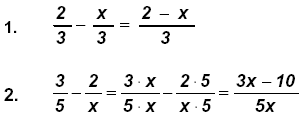Adding and Subtracting Fractions
FRACTION: If a and b are real numbers then the expression

is called a fraction. The top number a is called the numerator and the bottom
number b is called the denominator. Division by zero is not allowed, so b ≠ 0
or the result is undefined.
Adding fractions
Remember that for addition all fractions must have common
denominators. [The result must be checked to see if it will reduce to simpler form.]
I. Adding fractions with common denominators:
 Keep the
common denominator then add the numerators.
Follow all of the properties for “signed numbersâ€. Keep the
common denominator then add the numerators.
Follow all of the properties for “signed numbersâ€.
Example:

II. Adding fractions that do not have common denominators:

Example:
Factor the denominators and find the least
common denominator (LCD). Raise both
(or all) fractions to have the LCD, then add
the new numerators.
Example:

Equivalent Fractions: If the numerator and denominator are
multiplied by a
common factor the resulting expression is an equivalent fraction that has the same
numerical value.
Multiply fractions: Multiply numerators times numerators and
denominators times
denominators.

Add Fractions with Different Denominators:
If the fractions do not have common denominators [Factor the denominators and
find the LCD. ] RAIISE all fractions to have common denominators,

then add the resulting numerators.

→ Another approach to this is to write the
LCD in the denominator with a long
“overbar†-- write the “first numerator†then compare its denominator with the
LCD (the other factors will be the “missing factorâ€) which will be multiplied times
the numerator.
→ Next, remember that the “sign goes with the number that follows it†and write
the “next signed numerator†– compare its denominator with the LCD for the
“missing factor†to multiply times that numerator. Repeat for all fractions in the
sum.

Learn this well. These steps will also work with algebraic fractions that contain
variables so you will probably want to “bookmark†these pages.
Example:


Adding mixed numbers – integers and fractions
One of the problems that students have difficulty with occurs when one of the
“addends†is an integer. They forget that all integers have a denominator of 1.
Example 2:



III. In algebra some of the factors may be letters, or variables, which must be
treated as “prime factorsâ€. They will be left in the result as “literal sumsâ€.

|